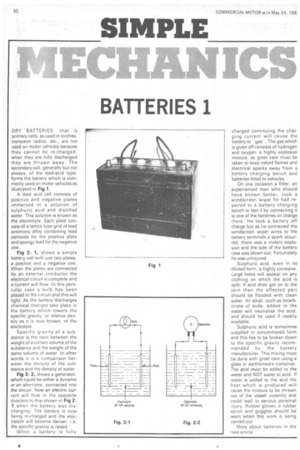SIMPLE
Page 32

If you've noticed an error in this article please click here to report it so we can fix it.
BATTERIES 1
DRY BATTERIES, that is primary cells, as used in torches, transistor radios, etc., are not used on motor vehicles because they cannot be re-charged; when they are fully discharged they are thrown away. The secondary cell, generally but not always, of the lead-acid type, forms the battery which is commonly used on motor vehicles as illustrated in Fig 1.
A lead acid cell consists of positive and negative plates immersed in a solution of sulphuric acid and distilled water. This solution is known as the electrolyte. Each plate con sists of a lattice type grid of lead antimony alloy containing lead peroxide for the positive plate and spongy lead for the negative one.
Fig 2: 1, r shows a simple battery cell with just two plates,
a positive and a negative one.
When the plates are connected by an external conductor the
electrical circuit is complete and a current will flow. In this particular case a bulb has been placed in the circuit and this will light. As the battery discharges' chemical changes take place in the battery which lowers the
specific gravity, or relative density as it is now known, of the electrolyte. .
Specific gravity of a substance is the ratio between the weight of a certain volume of the substance and the weight of the same volume of water. In other words it is a comparison between the density of the substance and the density of water.
Fig 2: 2, shows a generator, which could be either a dynamo or an alternator, connected into
the circuit. Now an electric current will flow in the opposite direction to that shown in Fig 2: 1 when the battery was discharging_ The battery is now being re-charged and the electrolyte will become denser, i.e. the specific gravity is raised. When a battery is fully
charged continuing the charging current will cause the battery to "gas". The gas which is given off consists of hydrogen and oxygen, a highly explosive mixture, so great care must be taken to keep naked flames and electrical aparks away from a battery charging bench and batteries fitted to vehicles.
On one occasion a fitter, an experienced man who should have known better, took a windscreen wiper he had repaired to a battery charging bench to test it by connecting it to one of the batteries on charge there. He took a battery off charge but as he connected the windscreen wiper wires to the battery terminals a spark occur red; there was a violent explosion and the side of the battery case was blown out. Fortunately he was uninjured.
Sulphuric acid, even. in its diluted form, is highly corrosive.
Large holes will appear on any clothing on which the acid is spilt. If acid does get on to the skin then the affected part should be flooded with clean water. An alkali, such as bicarb
onate of soda, added to the water will neutralise the acid, and should be used if readily available.
Sulphuric .acid is sometimes supplied in concentrated form and this has to be broken down to the specific gravity recommended by the battery manufacturer. This mixing must be done with great care using a glass or earthenware container.
The acid must be added to the water and NOT water to acid. If water is added to the acid the heat which is produced will cause the mixture to be thrown out of the vessel violently and could lead to serious personal injury. Rubber gloves, a rubber apron and goggles should be worn when this work is being carried out.
More about batteries in the next article.
































































































































